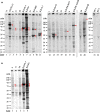Screening and characterization of myositis-related autoantibodies in COVID-19 patients
- PMID: 36271647
- PMCID: PMC9841303
- DOI: 10.1111/cts.13434
Screening and characterization of myositis-related autoantibodies in COVID-19 patients
Abstract
An efficient host immune response against severe acute respiratory syndrome coronavirus 2 (SARS-CoV-2, COVID-19) appears to be crucial for controlling and resolving this viral infection. However, many studies have reported autoimmune characteristics in severe COVID-19 patients. Moreover, clinical observations have revealed that COVID-19-associated acute distress respiratory syndrome shares many features in common with inflammatory myopathy including interstitial lung disease (ILD), most particularly rapidly progressive (RP)-ILD. This study explored this phenomenon by seeking to identify and characterize myositis-specific and related autoantibodies in 25 COVID-19 patients with mild or severe symptoms. Line blot analysis with the EUROLINE Myopathies Ag kit identified 9 (36%) patients with COVID-19 with one or more autoantibodies against several myositis-related antigens (Jo-1, Ku, Mi-2β, PL-7, PL-12, PM-Scl 75, PM-Scl 100, Ro-52, and SRP); no anti-MDA5 antibodies were detected. As the presence of antibodies identified by line blots was unrelated to disease severity, we further characterized the autoantibodies by radioimmunoassay, in which [35 S]methionine-labeled K562 cellular antigens were precipitated and visualized by gel electrophoresis. This result was confirmed by an immunoprecipitation assay and immunoblotting; 2 patients exhibited anti-Ku70 and anti-Ku80 antibodies. Our data suggest that it is necessary to use more than one method to characterize and evaluate autoantibodies in people recovered from COVID-19, in order to avoid misinterpreting those autoantibodies as diagnostic markers for autoimmune diseases.
© 2022 The Authors. Clinical and Translational Science published by Wiley Periodicals LLC on behalf of American Society for Clinical Pharmacology and Therapeutics.
Conflict of interest statement
The authors declared no competing interests for this work.
Figures


References
-
- Li J‐P, Chang S‐H, Tsay GJ, Chen D‐Y, Lan J‐L. Idiopathic inflammatory myopathy patients with different autoantibody exhibit unique peripheral blood T cell subsets. J Immunol. 2019;202:182.134.
Publication types
MeSH terms
Substances
LinkOut - more resources
Full Text Sources
Medical
Research Materials
Miscellaneous

